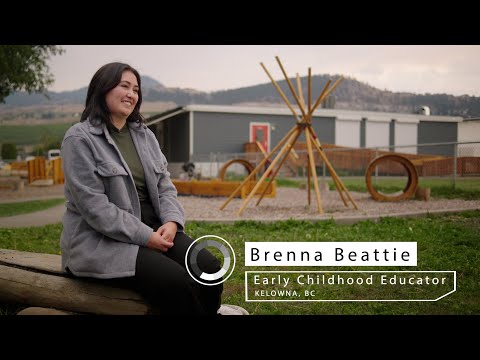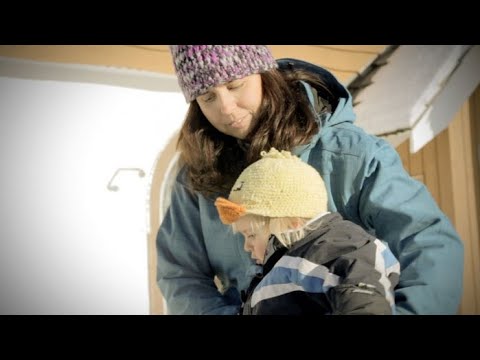Career Overview
Early childhood educators (ECEs) work with young children from birth to age five. They are researchers and collaborators in the creation of educational spaces that shape a child’s early development by fostering intellectual, physical, social and emotional growth. Early childhood educator assistants (ECEAs) work under the supervision of ECEs.
Job Titles
Duties
In general, ECEs and ECEAs work with children to:
- Offer curriculum that might include stories, music, play, field trips, art, drama and movement
- Support each child’s sense of identity and belonging
- Protect their health and safety
- Support their eating, dressing and toileting routines
- Observe and guide learning, development and behaviour
- Foster environments where diverse abilities, cultures, languages, traditions and heritages are celebrated
- Provide indoor and outdoor spaces that are inclusive and enriching
ECEs and ECEAs also:
- Build relationships with children’s families, guardians, co-workers and community services
- Do paperwork and keep records
- Develop curriculums
- Maintain a safe and clean environment that meets licensing requirements
- Prepare food
- Evaluate educational programs
- Take part in professional development
ECEs may also supervise and mentor others, including ECEAs and students.
ECEs and ECEAs use the B.C. Early Learning Framework to guide their work and maintain the standards set out in B.C.’s Child Care Licensing Regulation.
Earnings
Earnings is income that workers receive in exchange for their labour. Depending on the type of employment, earnings can be in the form of wages (hourly), salaries (fixed monthly or annual) or self-employed earnings.
Work Environment
# Workers Employed
20,530% Employed Full Time
33%ECEs and ECEAs work in a variety of settings, including licensed child care centres, StrongStart BC centres, family resources programs, before- and after-school programs or preschool programs. These can be in schools, community centres or workplaces that offer child care.
ECEs and ECEAs may work full time or part time, and hours vary. Preschool and school-based programs usually run during the school year. Most child care centres are open year-round. These may have longer hours or use staggered shifts to fit the needs of working parents. There is a growing demand for late-night child care to accommodate shift workers.
Working with young children and families can be rewarding. It can also be physically and emotionally demanding. Workers may suffer back strain or other discomfort, and exposure to illness. Educators should be aware of the physical and emotional demands of this work. Strong communication, patience and creativity are essential in this career, along with a deep understanding of child development and education best practices. Many resources are available to help ECEs and ECEAs develop healthy workplace strategies.
Career Pathways
Recent graduates often find jobs in child care centres, preschools, community centres or parks and recreation departments. They may be hired as ECEs or ECEAs, support workers for children’s diverse needs or before- and after-school educators.
ECEAs can become ECEs by completing their early childhood education basic certification.
There are many career pathways that ECEs can explore, including child care program and staff management, community outreach, child care licensing, infant development, education and supported child development consulting.
Related Careers
Occupational Interests
It’s important to understand what kinds of occupations align with your interests.
For more about occupational interests visit Skills for the Future Workforce > Characteristics.
Here are the top occupational interest(s) for this career profile:
Education, Training and Skills
Early childhood educators (ECEs) and assistants (ECEAs) must be certified to work in most licensed child care programs. There are five types of certification:
- ECEA
- ECE – one year
- ECE – five year
- Infant Toddler Educator (ITE)
- Special Needs Educator (SNE)
ECEs must complete an early childhood education program at a recognized university or college to be recognized in B.C. Upon completion, they must apply to be certified through the ECE Registry with the B.C. Ministry of Children and Family Development.
Requirements for ECEAs include completing courses in child development, children’s well-being and curriculum planning. Additional training and certification are available for those wanting to pursue ITE and SNE certifications.
ECEs must meet professional development, work experience, as well as character and skill requirements to stay certified.
The ECE Education Support Fund offers bursaries for ECE courses at approved post-secondary schools. The Specialized Certification Grant program offers grants to educators who hold their ITE or SNE certification. Other government and non-government funding programs are available to help students complete their ECE education.
ECEs certified by a regulator elsewhere in Canada can apply for the same certification from the regulator in B.C. Under the terms of the Canadian Free Trade Agreement (CFTA), most applicants who are transferring their credentials from elsewhere in Canada will not be required to complete additional training or testing. However, the B.C. regulator may ask applicants to provide further information such as a letter of good standing, references or criminal record check.
For those trained outside of Canada and who never received certification from any Canadian jurisdiction, a full assessment is likely needed. Most occupational regulators have a process for assessment and recognize internationally trained applicants.
Contact the B.C. Ministry of Children and Family Development: Early Childhood Educator Registry for details on how to apply for certification in B.C.
For information about labour mobility in Canada, visit www.workersmobility.ca.
View a list of Professional Regulatory Authorities in B.C.
Education programs in B.C.
The following program areas are related to this occupation:
- Early Childhood Education
- Teacher Assistant/Aide

Skills
Every job calls for a certain set of skills. Knowing those skills is the first step in finding a good career fit.
Here, you will find the 10 most relevant workplace skills. Some are more important to achieving success in a certain career than others. These skills may come naturally to you or you may need to gain them through education, training and experience.
See the list of work-related skills below, ranked in order of importance for this career. Check out the list and see if this career matches your skills—take that first step!
Giving full attention to what other people are saying, taking time to understand the points being made, asking questions as appropriate, and not interrupting at inappropriate times.
Being aware of others’ reactions and understanding why they react as they do.
Talking to others to share information effectively.
Keeping track of and assessing your performance, other individuals, or organizations to make improvements or take corrective action.
Using logic and reasoning to identify the strengths and weaknesses of alternative solutions, conclusions or approaches to problems.
Actively looking for ways to help people.
Adjusting actions in relation to others' actions.
Teaching others how to do something.
Understanding written sentences and paragraphs in work-related documents.
Considering the relative costs and benefits of potential actions to choose the most appropriate one.
Labour Market Statistics
Discover data, facts and information that have been gathered and analyzed. Learn about the characteristics of the economy and labour market in B.C.
Employment
Find out about employment types and trends by region and industry.
Employment
20,530Employment by Region







| Region | Employment | % Employment of this Occupation |
|---|---|---|
| Cariboo | 605 | 2.9% |
| Kootenay | 550 | 2.7% |
| Mainland/Southwest | 12,780 | 62.3% |
| North Coast and Nechako | 490 | 2.4% |
| Northeast | 270 | 1.3% |
| Thompson-Okanagan | 2,190 | 10.7% |
| Vancouver Island/Coast | 3,635 | 17.7% |
Labour Market Outlook
The B.C. Labour Market Outlook is a 10-year forecast of the expected supply and demand for labour in the province. It’s usually updated every year. The purpose is to provide British Columbians with the knowledge to make informed decisions on careers, skills training, education and hiring.
Forecasted Job Openings (2024-2034)
13,820Forecasted Job Openings
Forecasted Employment Growth Rate
Composition of Job Openings
Job Openings by Region (2024-2034)







| Region | Job Openings | Avg. Annual Employment Growth |
|---|---|---|
| Cariboo | 250 | 2.2% |
| Kootenay | 270 | 2.3% |
| Mainland/Southwest | 9,720 | 3.6% |
| North Coast and Nechako | 90 | 1.7% |
| Northeast | 80 | 1.6% |
| Thompson-Okanagan | 1,320 | 2.9% |
| Vancouver Island/Coast | 2,090 | 3.4% |
Industry Highlights
Learn about the opportunities in B.C.'s major industries, including employment trends, earning potential, locations of work and more.
Forecasted Job Openings by Industry
| Industry | Job Openings (2024-2034) |
|---|---|
| Health Care and Social Assistance | 11,800 |
| Educational Services | 1,350 |
| Information, Culture and Recreation | 260 |
| Repair, Personal and Non-Profit Services | 190 |
| Public Administration | 90 |
Insights from Industry
The demand for child care is growing and educator recruitment is essential. The need for qualified ECEs and ECEAs is high in B.C., particularly in rural areas. Educators who have specialized skills and certification to work with the infant toddler age group and children with diverse needs are also in high demand.
The B.C. Government has committed to significantly increase the number of child care spaces across the province, further driving demand.
This career can be demanding and rewarding. New and improved supports have led to significant progress in wages and educational supports.
Resources
-
Aboriginal Head Start Association of British Columbiawww.ahsabc.com
-
BC Aboriginal Child Care Societywww.acc-society.bc.ca
-
B.C. Child Care Resource and Referral Centreswww.gov.bc.ca/ChildCareResourceReferralCentres
-
B.C. Early Learning Frameworkwww2.gov.bc.ca/gov/content/education-training/early-learning/teach/early-learning-framework
-
B.C. Ministry of Education – Early Learningwww.gov.bc.ca/earlylearning
-
Become an Early Childhood Educator – Government of B.C.www2.gov.bc.ca/gov/content/education-training/early-learning/teach/training-and-professional-development/become-an-early-childhood-educator
-
The Canadian Association for Young Children (CAYC)www.cayc.ca
-
Canadian Child Care Federation (CCCF)www.cccf-fcsge.ca
-
Child Care Human Resources Sector Council (CCHRSC)www.ccsc-cssge.ca
-
Coalition of Child Care Advocates of BC (CCCABC)www.cccabc.bc.ca
-
Early Childhood Educators of BC (ECEBC)www.ecebc.ca
-
Métis Nation BC – Early Learning K-12www.mnbc.ca/education
-
Ministry of Health – Types of child care in B.C.www2.gov.bc.ca/gov/content/family-social-supports/caring-for-young-children/family-information/licensed-unlicensed-child-care
-
School Age Child Care Association of British Columbia (SACCABC)saccabc.org










